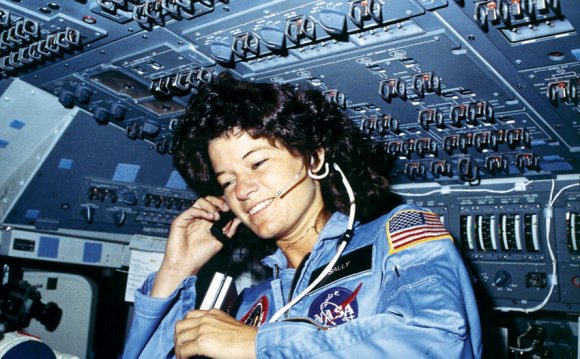
Sally Ride (born 1951) is best known as the first American woman sent into outer space. She also served the National Aeronautics and Space Administration (NASA) in an advisory capacity, being the only astronaut chosen for President Ronald Reagan's Rogers Commission investigating the mid-launch explosion of the space shuttle Challenger in January, 1986, writing official recommendation reports, and creating NASA's Office of Exploration.
Both scientist and professor, Sally Ride has served as a fellow at the Stanford University Center for International Security and Arms Control, a member of the board of directors at Apple Computer Inc., and a space institute director and physics professor at the University of California at San Diego. Ride has chosen to write primarily for children about space travel and exploration. Her commitment to educating the young earned her the Jefferson Award for Public Service from the American Institute for Public Service in 1984, in addition to her National Space-flight Medals recognizing her two groundbreaking shuttle missions in 1983 and 1984. Newly elected president Bill Clinton chose her as a member of his transition team during the fall of 1992.
Sally Kristen Ride is the older daughter of Dale Burdell and Carol Joyce (Anderson) Ride of Encino, California, and was born May 26, 1951. As author Karen O'Connor describes tomboy Ride in her young reader's book, Sally Ride and the New Astronauts, Sally would race her dad for the sports section of the newspaper when she was only five years old. An active, adventurous, yet also scholarly family, the Rides traveled throughout Europe for a year when Sally was nine and her sister Karen was seven, after Dale took a sabbatical from his political science professorship at Santa Monica Community College. While Karen was inspired to become a minister, in the spirit of her parents, who were elders in their Presbyterian church, Ride's own developing taste for exploration would eventually lead her to apply to the space program almost on a whim. "I don't know why I wanted to do it, " she confessed to Newsweek prior to embarking on her first spaceflight.
The opportunity was serendipitous, since the year she began job-hunting marked the first time NASA had opened its space program to applicants since the late 1960s, and the very first time women would not be excluded from consideration. NASA needed to cast a wider net than ever before, as Current Biography disclosed in 1983. The program paid less than private sector counterparts and offered no particular research specialties, unlike most job opportunities in academia. All it took was a return reply postcard, and Ride was in the mood to take those risks. This was, after all, a young lady who could patch up a disabled Toyota with Scotch tape without breaking stride, as one of her friends once discovered. Besides, she had always forged her own way before with the full support of her open-minded family.
RELATED VIDEO




 Lake Powell is a reservoir on the Colorado River, straddling the border between Utah and Arizona (most of it, along with Rainbow Bridge, is in Utah). It is the second largest man-made reservoir in maximum water capacity in the United States behind Lake Mead, storing...
Lake Powell is a reservoir on the Colorado River, straddling the border between Utah and Arizona (most of it, along with Rainbow Bridge, is in Utah). It is the second largest man-made reservoir in maximum water capacity in the United States behind Lake Mead, storing...








